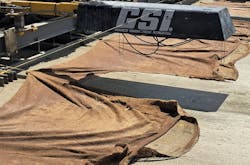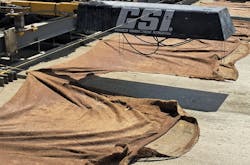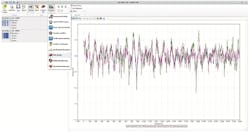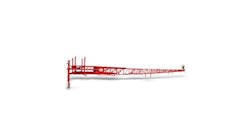By: Gary Fick and David Merritt
Drivers judge the quality of a roadway primarily by its ride quality. As a result, the primary motivation behind specifications for initial smoothness (construction acceptance) is generally driver satisfaction, or functional performance.
There is evidence, however, that smoother pavements also lead to improved structural performance and remain smoother longer. In performance terms, smoother pavements last longer and stay smoother longer.
One tool that can be used to improve as-constructed smoothness is real-time smoothness (RTS) measurements. RTS profiles are generally measured on the surface of the fresh concrete, directly behind the paver, prior to any finishing, texturing and joint sawing processes. The Federal Highway Administration (FHWA), through the Second Strategic Highway Research Program (SHRP2), funded an implementation project with the goal of eventually achieving routine use of RTS measuring technologies by owner agencies and paving contractors. In this project, two RTS systems were purchased, and 11 contractors participated in an equipment loan program to better understand RTS and its implementation.
Exit interviews were conducted with the contractors after each equipment loan. The consensus among contractors was that RTS systems are beneficial in identifying factors in the paving process that contribute to initial pavement roughness. The RTS system reduces the risk of making adjustments to the paving process because the real-time feedback gives an indication of the impact of any adjustments on pavement smoothness, positive or negative, within an hour or two instead of on the following day, after the hardened profiles are measured. Making the proper adjustments to the paving processes requires knowledge and experience of the paving mixture and the paving equipment. Using an RTS system can shorten the learning curve for inexperienced crews because it is easier to see the impacts of process changes on initial smoothness in real time than on the following day, when hardened profiles are available.
The RTS system reduces the risk of making adjustments to the paving process because the real-time feedback gives an indication of the impact of any adjustments on pavement smoothness, positive or negative, within an hour or two instead of on the following day.
The during and after
Real-time and hardened profiles are not identical to each other. Hardened profiles are measured after finishing processes and after the concrete has transitioned from a plastic to a rigid state. For this reason, the smoothness, or International Roughness Index (IRI), values also are expected to be different, but how much different depends on many factors.
Two methods used to compare real-time and hardened profiles are a comparison of smoothness values (IRI, Profile Index – Prl, etc.) and the comparison of spectral content. The latter can be analyzed with a Power Spectral Density (PSD) module within FHWA’s ProVal software. This module helps to identify the impacts of repeating patterns in profile data caused by some aspect of the pavement process on the smoothness results.
Because paving is very repetitive by nature, with the same process repeated over and over throughout the day’s operation, certain features of the pavement itself or processes in the operation can leave patterns in the pavement profile (both real-time and hardened). A PSD analysis helps to identify these patterns to determine if anything can be done to mitigate the cause.
The case studies, along with analysis of data from the rest of the equipment loans, have revealed some key findings pertinent to the relationship between real-time and hardened profile data. With regard to smoothness results, there is no definitive relationship between real-time versus hardened smoothness values that can be applied to all projects.
In general, real-time smoothness results (IRI, Prl, etc.) will be higher (rougher) than hardened data, but not by a fixed amount. And the higher the real-time values, the greater the difference between the real-time and hardened values. For the projects in this study, real-time numbers ranged from less than 2 in./mile to over 95 in./mile higher than the hardened numbers.
Finally, the relationship will be project-specific and will need to be established during the first few days of a paving project for the contractor to use the real-time data to adjust paving processes.
Other lessons learned include:
- Load-transfer dowels and bar supports are typically the dominant influence on real-time profiles;
- Proper hand-finishing techniques typically improve the initial hardened IRI by reducing short-wavelength roughness;
- An RTS system can help identify impacts on smoothness and then can be used to evaluate the process and/or material adjustments taken to improve initial smoothness; and
- An RTS system can help contractors prepare for a change in smoothness acceptance criteria (e.g. from Prl to IRI).
The project team’s experience with the Ames RTP and Gomaco GSI through 11 equipment loans revealed that both of these systems are rugged and perform well under highly variable conditions. Both systems were equally capable of accurately measuring the real-time profile.
Take these steps
Based on the experience gained through the equipment loans, the project team developed a step-by-step process recommended for contractors implementing an RTS system:
1. In the purchase of an RTS system, factors that should be considered when choosing the system include:
- Ease of mounting and switching between multiple pavers;
- Field ruggedness;
- Familiarity with operating software; and
- Cost.
The project team’s experience with the Ames RTP and Gomaco GSI through 11 equipment loans revealed that both of these systems are rugged and perform well under highly variable conditions. While there are differences between the user interface and sensor technology (laser or acoustic), both systems were equally capable of accurately measuring the real-time profile and providing the contractor with the feedback necessary for confidently making adjustments to the paving process.
2. Install and operate the RTS system with the sensor(s) near the middle of each lane.
One sensor per lane is adequate for monitoring real-time smoothness. It is not necessary—and many times impractical—to mount the sensors directly in line where hardened profiles will be measured. It is desirable to compare the real-time profiles to the hardened profiles. However, the data obtained from the equipment loans has shown that even when these profiles are taken at points across the pavement, they often show very close agreement with respect to profile features (bumps and dips). In situations where the real-time and hardened profiles are not similar, it is recommended to check to make sure that the start and end stations of both profiles are the same, and eliminate the first 100 to 200 ft of paving from the profile comparison because this is normally where adjustments are still being made to the paver coming off the header.
If the profile features still do not match, this may be indicative of the effects of hand-finishing or that the paver is in need of adjustment. The lateral location of the RTS sensors can be adjusted to assist in troubleshooting specific areas across the width of the paver that are consistently rougher (e.g., at tie-bar insertion points or breaks in the cross-slope). After troubleshooting has been performed, return the RTS sensors to the center of each lane. It is important to develop a file name structure for both real-time and hardened data sets to ease identification and comparison.
3. For each new installation and for first-time use on each project, begin by passively using the RTS system to establish a baseline of smoothness results.
Monitor real-time and hardened profile results for one to two days, and make ordinary paving process adjustments concerning mixture, vibrators, speed, head and stoppage.
Observe typical responses to the ordinary adjustments and make notes or add event markers in the RTS. Real-time and hardened smoothness values will not be the same. This is typical; by focusing on reducing the real-time numbers, the hardened values also will be reduced.
Use a software tool such as ProVAL to perform a PSD analysis of real-time and hardened profile data. Look for repeating features but focus on features that show up in both profiles.
4. After establishing a baseline of real-time smoothness numbers and a general relationship between the real-time and hardened values, begin actively using the real-time smoothness feedback.
Reduce or eliminate large profile events, such as stringline or stringless system interference, paver stops, pad line issues, fluctuation of the paver head, and non-uniformity of the concrete mixture. Eliminating large profile events yields a new baseline smoothness value and a new relationship between real-time and hardened values.
5. As necessary, make systematic and incremental adjustments to the paving process to improve overall smoothness.
Monitor the real-time feedback for approximately 0.1 miles of consistent paving (i.e., during an absence of any of the large profile events described above). Determine whether the adjustment had an impact on smoothness numbers and continue making small incremental adjustments. These adjustments can include, but are not limited to:
- Maintaining a consistent head of concrete in the paver (e.g., between the metering gates and main pan);
- Minimizing lead/draft to get the paver as flat as possible;
- Adjusting the hydraulic and/or stringless sensitivities that control the rate of reaction of the elevation controls of the paver relative to the stringline or 3-D model input;
- Adjusting vibrator height and frequency;
- Adjusting the mixture workability and uniformity; and
- Matching paving speed to the concrete delivery rate or to the improved IRI results if paver stops are not introducing localized roughness.
6. Identify repeating features in the real-time profiles using a PSD analysis.
Use a software tool such as ProVAL to perform a PSD analysis of real-time and hardened profile data. Look for repeating features but focus particularly on features that show up in both the real-time and hardened profiles.
These profile features may prove difficult to mitigate, but if they consistently dominate the spectral content in the PSD analysis this indicates that most of the other impacts on initial pavement roughness have been mitigated to some degree. The most common repeating features include:
- Load transfer dowels (joint spacing) for jointed concrete pavement;
- Transverse bar supports for continuously reinforced concrete pavement;
- Concrete load spacing; and
- Stringline pin spacing.
This project also included marketing and outreach efforts. A quick reference guide provides key information about RTS installation, daily startup and shutdown, and recommendations for maximizing the benefits of the technology. In addition, an index was developed (www.cptechcenter.org/real-time-smoothness/) as a magnet that can be affixed to the frame of a slipform paver.
About The Author: Fick is with Trinity Construction Management Services Inc. Merritt is with The Transtec Group Inc.





